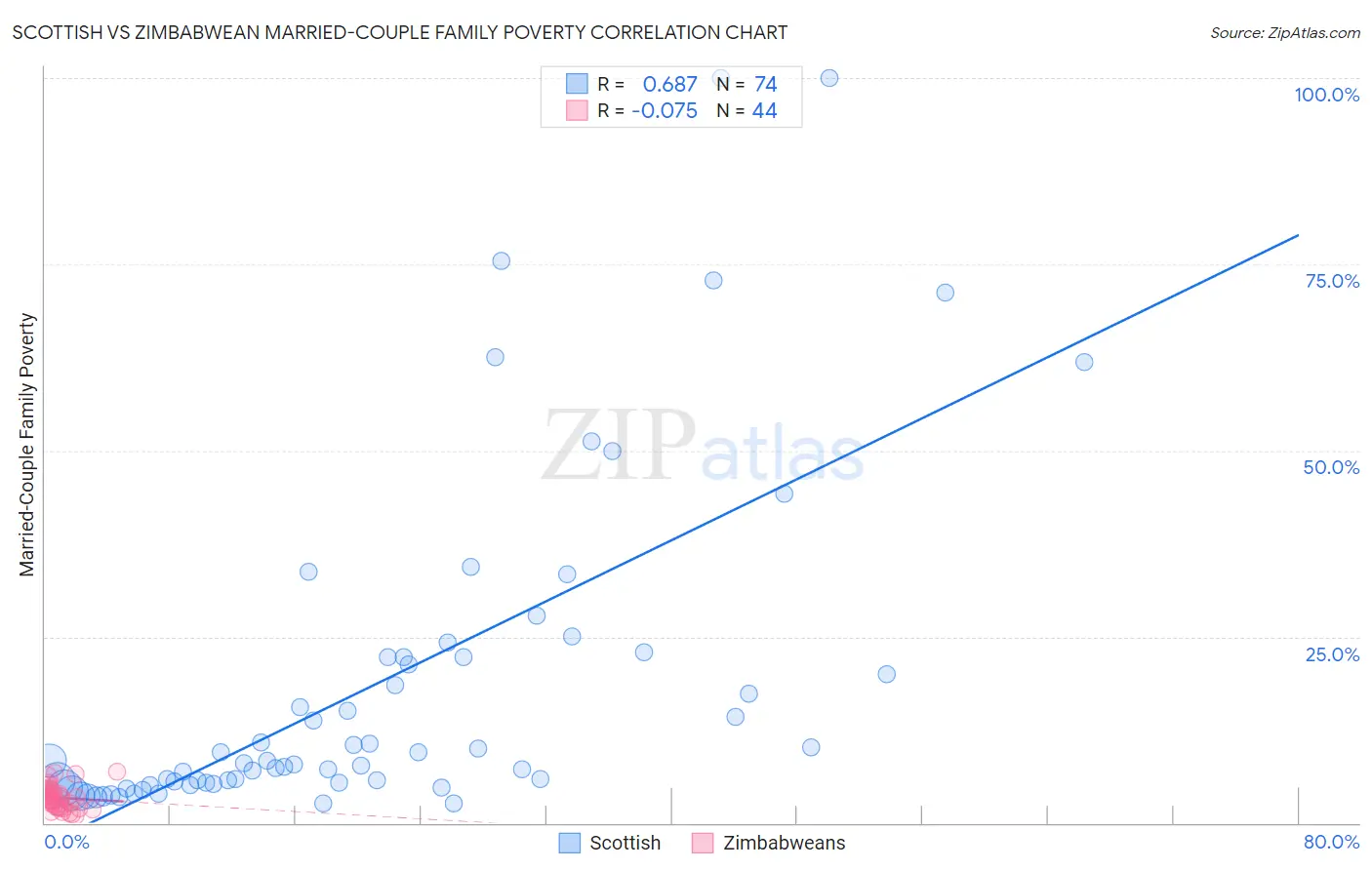Scottish vs Zimbabwean Married-Couple Family Poverty
COMPARE
Scottish
Zimbabwean
Married-Couple Family Poverty
Married-Couple Family Poverty Comparison
Scottish
Zimbabweans
4.3%
MARRIED-COUPLE FAMILY POVERTY
99.8/ 100
METRIC RATING
42nd/ 347
METRIC RANK
4.1%
MARRIED-COUPLE FAMILY POVERTY
99.9/ 100
METRIC RATING
21st/ 347
METRIC RANK
Scottish vs Zimbabwean Married-Couple Family Poverty Correlation Chart
The statistical analysis conducted on geographies consisting of 552,662,179 people shows a significant positive correlation between the proportion of Scottish and poverty level among married-couple families in the United States with a correlation coefficient (R) of 0.687 and weighted average of 4.3%. Similarly, the statistical analysis conducted on geographies consisting of 69,119,087 people shows a slight negative correlation between the proportion of Zimbabweans and poverty level among married-couple families in the United States with a correlation coefficient (R) of -0.075 and weighted average of 4.1%, a difference of 4.6%.

Married-Couple Family Poverty Correlation Summary
| Measurement | Scottish | Zimbabwean |
| Minimum | 2.6% | 1.0% |
| Maximum | 100.0% | 6.9% |
| Range | 97.4% | 5.9% |
| Mean | 18.6% | 3.4% |
| Median | 8.2% | 3.4% |
| Interquartile 25% (IQ1) | 5.4% | 2.2% |
| Interquartile 75% (IQ3) | 22.2% | 4.3% |
| Interquartile Range (IQR) | 16.8% | 2.1% |
| Standard Deviation (Sample) | 22.5% | 1.5% |
| Standard Deviation (Population) | 22.4% | 1.5% |
Similar Demographics by Married-Couple Family Poverty
Demographics Similar to Scottish by Married-Couple Family Poverty
In terms of married-couple family poverty, the demographic groups most similar to Scottish are Northern European (4.3%, a difference of 0.16%), French Canadian (4.2%, a difference of 0.41%), Swiss (4.3%, a difference of 0.44%), Immigrants from Northern Europe (4.2%, a difference of 0.70%), and Immigrants from Japan (4.3%, a difference of 0.81%).
| Demographics | Rating | Rank | Married-Couple Family Poverty |
| Europeans | 99.9 /100 | #35 | Exceptional 4.2% |
| English | 99.9 /100 | #36 | Exceptional 4.2% |
| Iranians | 99.9 /100 | #37 | Exceptional 4.2% |
| Belgians | 99.9 /100 | #38 | Exceptional 4.2% |
| Immigrants | Northern Europe | 99.8 /100 | #39 | Exceptional 4.2% |
| French Canadians | 99.8 /100 | #40 | Exceptional 4.2% |
| Northern Europeans | 99.8 /100 | #41 | Exceptional 4.3% |
| Scottish | 99.8 /100 | #42 | Exceptional 4.3% |
| Swiss | 99.8 /100 | #43 | Exceptional 4.3% |
| Immigrants | Japan | 99.8 /100 | #44 | Exceptional 4.3% |
| Serbians | 99.8 /100 | #45 | Exceptional 4.3% |
| British | 99.8 /100 | #46 | Exceptional 4.3% |
| Immigrants | South Central Asia | 99.8 /100 | #47 | Exceptional 4.3% |
| Australians | 99.7 /100 | #48 | Exceptional 4.3% |
| Turks | 99.7 /100 | #49 | Exceptional 4.3% |
Demographics Similar to Zimbabweans by Married-Couple Family Poverty
In terms of married-couple family poverty, the demographic groups most similar to Zimbabweans are Maltese (4.1%, a difference of 0.030%), Immigrants from Ireland (4.1%, a difference of 0.27%), Immigrants from Singapore (4.1%, a difference of 0.37%), Bhutanese (4.1%, a difference of 0.39%), and Eastern European (4.1%, a difference of 0.62%).
| Demographics | Rating | Rank | Married-Couple Family Poverty |
| Slovaks | 100.0 /100 | #14 | Exceptional 4.0% |
| Poles | 100.0 /100 | #15 | Exceptional 4.0% |
| Germans | 100.0 /100 | #16 | Exceptional 4.0% |
| Filipinos | 100.0 /100 | #17 | Exceptional 4.0% |
| Italians | 100.0 /100 | #18 | Exceptional 4.0% |
| Immigrants | Ireland | 99.9 /100 | #19 | Exceptional 4.1% |
| Maltese | 99.9 /100 | #20 | Exceptional 4.1% |
| Zimbabweans | 99.9 /100 | #21 | Exceptional 4.1% |
| Immigrants | Singapore | 99.9 /100 | #22 | Exceptional 4.1% |
| Bhutanese | 99.9 /100 | #23 | Exceptional 4.1% |
| Eastern Europeans | 99.9 /100 | #24 | Exceptional 4.1% |
| Immigrants | Taiwan | 99.9 /100 | #25 | Exceptional 4.1% |
| Cypriots | 99.9 /100 | #26 | Exceptional 4.1% |
| Danes | 99.9 /100 | #27 | Exceptional 4.1% |
| Scandinavians | 99.9 /100 | #28 | Exceptional 4.1% |